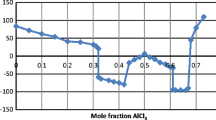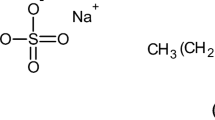Abstract
The local structure of cellulose, dissolved in the frequently used ionic liquid EMIm-OAc, is modelled by a coaxial double layer cylinder. The cylinder’s core consists of a cellulose chain while the sheath is formed by a solvent layer with lower electron density than the bulk solvent. We studied 2% cellulose solutions in EMIm-OAc and their behavior upon addition of increasing amounts of water. At this cellulose concentration, 15 wt% of water induced the precipitation of cellulose. Water molecules did not form an independent phase, but were bound to EMIm-OAc in the cellulose/water/EMIm-OAc solution. The conformational of a cellulose chain changes by adding water into the solution, and the square of the apparent cross-sectional radius of gyration of the cellulose chain becomes zero to negative. This phenomenon is explained by the formation of a solvation shell with lower electron density than the bulk solvent around the cellulose chain.






Similar content being viewed by others
References
Ahn K, Zaccaron S, Rosenau T, Potthast A (2019) How alkaline solvents in viscosity measurements affect data for oxidatively damaged celluloses. Part 1. Cupri-ethylenediamine (CED, cuen). Biomacromolecules 20(11):4117–4125
Barthel S, Heinze T (2006) Acylation and carbanilation of cellulose in ionic liquids. Green Chem 8:301–306
Bengtsson J, Olsson C, Hedlund A, Köhnke T, Bialik E (2017) Understanding the inhibiting effect of small-molecule hydrogen bond donors on the solubility of cellulose in tetrabutylammonium acetate/DMSO. J Phys Chem B 121(50):11241–11248
Chen Y, Zhang Y, Ke F, Zhou J, Wang H, Liang D (2011) Solubility of neutral and charged polymers in ionic liquids studied by laser light scattering. Polymer 52:481–488
Cho HM, Gross AS, Chu JW (2011) Dissecting force interactions in cellulose deconstruction reveals the required solvent versatility for overcoming biomass recalcitrance. J Am Chem Soc 133:14033–14041
Ebner G, Schiehser S, Potthast A, Rosenau T (2008) Side reaction of cellulose with common 1-alkyl-3-methylimidazolium-based ionic liquids. Tetrahedron Lett 49:7322–7732
Fukaya Y, Hayashi K, Wada M, Ohno H (2008) Cellulose dissolution with polar ionic liquids under mild conditions: required factors for anions. Green Chem 10:44–46
Gericke M, Schlufter K, Liebert T, Heinze T, Budtova T (2009) Rheological properties of cellulose/ionic liquid solutions: from dilute to concentrated states. Biomacromolecules 10:1188–1194
Ghoshdastidar D, Senapati S (2016) Ion-water wires in imidazolium-based ionic liquid/water solutions induce unique trends in density. Soft Matter 12:3032–3045
Hedlund A, Köhnke T, Theliander H (2015) Coagulation of EmimAc-cellulose solutions: dissolution-precipitation disparity and effects of non-solvents and cosolvent. Nordic Pulp Pap Res J 30(1):32–42
Heinze T, Schwikal K, Barthel S (2005) Ionic liquids as reaction medium in cellulose functionalization. Macromol Biosci 5:520–525
Henniges U, Kostic M, Borgards A, Rosenau T, Potthast A (2011) Dissolution behavior of different celluloses. Biomacromolecules 12:871–879
Kajiwara K, Wataoka I (2016) The method of small-angle X-ray scattering and its application to the structural analysis of oligo- and polysaccharides in solution. In: Matricardi P, Alhaique Coviello FT (eds) Polysaccharide hydrogels: characterization and biomedical applications. Pan Stanford Publishing, Singapore, pp 265–323
Koide M, Wataoka I, Urakawa U, Kajiwara K, Henniges U, Rosenau T (2019) Intrinsic characteristics of cellulose chain in ionic liquid: the shape of a single cellulose molecule. Cellulose 26(4):2233–2242
Le KA, Rudaz C, Budtova T (2014) Phase diagram, solubility limit and hydrodynamic properties of cellulose in binary solvents with ionic liquid. Carbohydr Polym 105:237–243
Liebner F, Ebner G, Becker E, Potthast A, Rosenau T (2010) Thermal aging of 1-alkyl-3-methylimidazolium ionic liquids and its effect on dissolved cellulose. Holzforschung 64:161–166
Liu H, Sale KL, Holmes BM, Simmons BA, Singh S (2010) Understanding the interactions of cellulose with ionic liquids: a molecular dynamics study. J Phys Chem B 114:4293–4301
Livsey I (1987) Neutron scattering from concentric cylinders. J Chem Soc Faraday Trans 2 83:1445–1452
Lynden-Bell RM, Del Popolo MG, Youngs TG, Kohanoff J, Hanke CG, Harper JB, Pinilla CC (2007) Simulations of ionic liquids, solutions, and surfaces. Acc Chem Res 40:1138–1145
Mazza M, Catana DA, Vaca-Garcia C, Cecutti C (2008) Influence of water on the dissolution of cellulose in selected ionic liquids. Cellulose 16:207–215
Miyamoto H, Sakakibara K, Wataoka I, Tsujii Y, Yamane C, Kajiwara K (2018) Interaction of water molecules with carboxyalkyl cellulose. In: Potthast A, Rosenau T (eds) Advances in cellulose science and technology: chemistry, analysis, and applications. Wiley, New York, pp 127–141
Mori T, Chikayama E, Tsuboi Y, Ishida N, Shisa N, Noritake Y, Moriya S, Kikuchi J (2012) Exploring the conformational space of amorphous cellulose using NMR chemical shifts. Carbohydr Polym 90:1197–1203
Moulthrop JS, Swatloski RP, Moyna G, Rogers RD (2005) High-resolution 13C NMR studies of cellulose and cellulose oligomers in ionic liquid solutions. Chem Commun 12:1557–1559
Olsson C, Idstrom A, Nordstierna L, Westman G (2014) Influence of water on swelling and dissolution of cellulose in 1-ethyl-3-methylimidazolium acetate. Carbohydr Polym 99:438–446
Parviainen H, Parviainen A, Virtanen T, Kilpelainen I, Ahvenainen P, Serimaa R, Gronqvist S, Maloney T, Maunu SL (2014) Dissolution enthalpies of cellulose in ionic liquids. Carbohydr Polym 113:67–76
Potthast A, Rosenau T, Henniges U, Schiehser S, Kosma P, Saake B, Lebioda S, Radosta S, Vorwerg W, Wetzel H, Koschella A, Heinze T, Strobin G, Sixta H, Strlic M, Isogai A (2015) Comparison testing of methods for gel permeation chromatography of cellulose: coming closer to a standard protocol. Cellulose 22(3):1591–1613
Rabideau BD, Agarwal A, Ismail AE (2013) Observed mechanism for the breakup of small bundles of cellulose I(alpha) and I(beta) in ionic liquids from molecular dynamics simulations. J Phys Chem B 117:3469–3479
Rosenau T, Potthast A, Kosma P, Chen CL, Gratzl JS (1999) Autocatalytic decomposition of n-methylmorpholine-n-oxide induced by mannich intermediates. J Org Chem 64:2166–2167
Rosenau T, Potthast A, Kosma P, Saariaho AM, Vuorinen T, Sixta H (2005) On the nature of carbonyl groups in cellulosic pulps. Cellulose 12:43–50
Swatloski RP, Spear SK, Holbrey JD, Rogers RD (2002) Dissolution of cellulose with ionic liquids. J Am Chem Soc 124:4974–4975
Uto T, Yamamoto K, Kadokawa J (2018) Cellulose crystal dissolution in imidazolium-based ionic liquids: a theoretical study. J Phys Chem B 122:258–266
Youngs TGA, Holbrey JD, Mullan CL, Norman SE, Lagunas MC, D’Agostino C, Mantle MD, Gladden LF, Bowron DT, Hardacre C (2011) Neutron diffraction, NMR and molecular dynamics study of glucose dissolved in the ionic liquid 1-ethyl-3-methylimidazolium acetate. Chem Sci 2:1594–1605
Zhao Y, Liu X, Wang J, Zhang S (2013) Effects of anionic structure on the dissolution of cellulose in ionic liquids revealed by molecular simulation. Carbohydr Polym 94:723–730
Acknowledgments
This work was performed under the approval of the Photon Factory Program Advisory Committee (Proposal No. 2014G604 and 2015G147). This work was financially supported by the Center for Fiber Textile Science in Kyoto Institute of Technology, and the Astrian Biorefinery Center Tulln (ABCT). We gratefully acknowledge and the work of past and present members of our laboratories involved in the work.
Author information
Authors and Affiliations
Corresponding author
Additional information
Publisher's Note
Springer Nature remains neutral with regard to jurisdictional claims in published maps and institutional affiliations.
Rights and permissions
About this article
Cite this article
Koide, M., Urakawa, H., Kajiwara, K. et al. Influence of water on the intrinsic characteristics of cellulose dissolved in an ionic liquid. Cellulose 27, 7389–7398 (2020). https://doi.org/10.1007/s10570-020-03323-2
Received:
Accepted:
Published:
Issue Date:
DOI: https://doi.org/10.1007/s10570-020-03323-2




